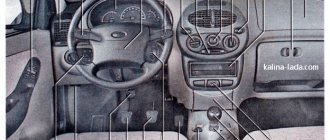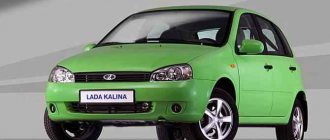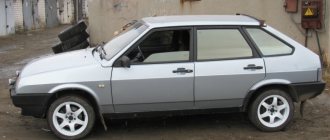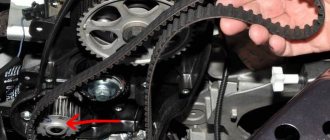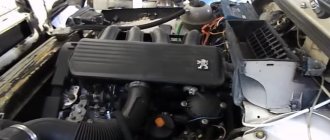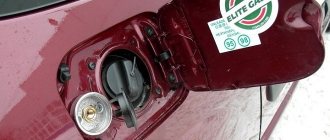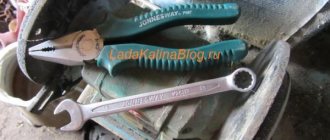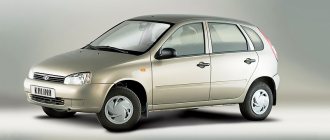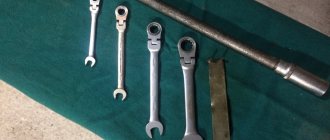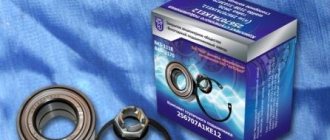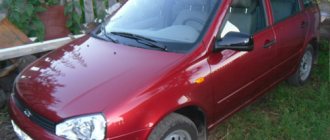The LADA Kalina, which is produced by AvtoVAZ PJSC, has gained nationwide popularity in the Russian Federation. It has a large number of admirers, has its own club, and many forums on the Internet are dedicated to discussing this car. But some malfunctions are typical for Kalina, which is why repairing this car is a sore subject for many of its owners.
In fact, repairing a Lada Kalina car yourself is not so difficult. From this article you will learn about the most vulnerable parts of the car, the most common breakdowns and how to eliminate them.
List of works during maintenance 1 (mileage 2500 - 3000 km)
- Changing the engine oil and oil filter. Oil specification: according to API SG, SH, SJ, SL. Depending on the region, the viscosity of the oil is selected. Oil volume 3.5 l. Oil filter catalog numbers - 2105-1012005, 2108-1012005, 2108-1012005-07. The cost of the original filter is from $1.67 to $2.15.
- Check the tightness of the camshaft caps (this item is performed only during the first maintenance).
- Adjust valve clearances.
Note. Since April 2013, cars that were sold with semi-synthetic oil (5W30) with sixteen-valve engines have not undergone the first maintenance. With eight valves, only the valves are adjusted.
Checks during the first maintenance
- no engine knock;
- checking the tightness of the motor mounts;
- no engine oil leaks;
- check the cooling system;
- tightness of the fuel system;
- presence of errors recorded by the ECU;
- check the exhaust system and muffler suspension;
- clutch operation;
- check for oil leaks on the transmission;
- condition of the gear shift mechanism boots;
- gearbox operation;
- the operation of the CV joint and the integrity of the anthers;
- condition of tires and rims, wheel balancing;
- operation and condition of the suspension for operating noise and integrity;
- wheel alignment;
- steering boots and steering serviceability;
- condition of the brake system pipes for integrity and absence of leaks;
- brake light switch clearance;
- handbrake operation and brake efficiency, brake fluid level;
- generator serviceability;
- all lamps and sound signal;
- headlight range control and headlight direction;
- glass and seat heaters;
- serviceability of instrument panel indicators;
- all modes of windshield wipers and washers;
- electronic mirrors;
- serviceability of locks;
- stove operation.
The design of this brake element
There are two types of disc calipers - front and rear, their design and repair method are slightly different, but their main elements are the same:
- The housing in which the piston (cylinder) is mounted.
- Bypass valve.
- Sealing ring.
- Piston (cylinder).
- Cylinder boot.
- Retaining ring.
- Frame.
- Pressure bar.
- Pads.
- Guide boot.
- Guides.
- 14. Fastening bolt.
- Brake hose.
The difference between the rear disc caliper is the presence of a parking brake.
Therefore, the piston (4) has a special thread through which it is screwed onto the parking brake rod (1). Thanks to this, it can operate under the influence of two drives - mechanical (parking) and hydraulic.
List of works during maintenance 2 (mileage 14500 - 15000 km)
- All maintenance work 1 (except for those specified in paragraph 2).
- Replacing the cabin filter. Original code - 11180812201000. Cost 1.65$ - 2.17$.
- Lubricating hinges and door stops.
- Cleaning the drainage holes of thresholds and doors.
Checks during the second maintenance
- timing belt condition;
- coolant level;
- gearbox oil level;
- steering play;
- wear of all brake pads;
- alternator belt condition;
- density and electrolyte level in the battery.
Typical faults
Repairing a Lada Kalina is not a very difficult task, you just need to know the main “pain points”. Significant problems are rare, but minor malfunctions are quite common. The clutch cannot boast of a high level of reliability and sufficient power reserve, regardless of the type of engine; it begins to fail after about forty thousand runs. The main problem is with the disk.
It is recommended to monitor the oil level - it begins to leak through the gaskets or burns on the piston rings. The instrument panel is equipped only with an oil pressure warning lamp, there is no dial indicator. Constant lighting of the lamp warns that the crankshaft may knock. Increased noise is often heard at the gearbox. It is difficult to get rid of the humming noise; sometimes neither changing the bearings nor adding good quality oil will help. Noise can be present even in new cars. The engine thermostat is another problem. Its valve can jam at any moment.
List of works during maintenance 6 (mileage 74,500 - 75,000 km)
- All maintenance work 2.
- Replace the timing belt. Belt number for 8-valve engine 2108 1006040 10, cost $5.15. The timing belt kit for a 16-valve engine has the number K015631XS and costs from $39.82 to $45.46.
- Replace coolant. System volume 7.8 l. Fluids used: OZHK-K HT, OZH-40-XT, OZH-65-XT, OZHK Tosol, OZH-40, OZH-65, OZHK-K SK, OZH-40SK, OZH-65SK, LADA-A40, OZH- To Sol-TS, OZh-40 Antifreeze-TS, OZh-65 Antifreeze TS, Antifreeze G48, AGIP ANTIFREEZE EXTRA, GLYSANTIN G 03, GLYSANTIN G 91.
- Replace the lambda probe. Number 1118 3850010. Price 39.07$ - 46.32$
- Change the oil in the gearbox. API oil specification is GL-4. Viscosity 75W90, 80W85, 85W90. Volume 3.1 l.
Examples of tuning lada kalina
1. Lada Kalina Hatchback Sport. Owner – Kirill Lavrov, Tyumen.
The owner, with the help of the guys from the Kiwamaru Sport drag team, built a real sports car without external tinsel. Participates in the national class in the Russian touring racing championship, previously in the Czech Republic in track racing in the N-1600 class.
Quote: “It should be understood that we are constrained by the regulations of the Russian Championship. Essentially, we are driving a standard engine, but we are replacing all internal parts with forged ones. Races, years and results have proven that forging is much stronger than stock and is worth the money.”
What was done and how much did it cost:
Engine:• Pistons – 20,000 rubles;• Connecting rods – 15,000 rubles;• Shaft – 7,500 rubles;• Additional 4.5 mm head with assembly – about 20,000 rubles;• Large receiver (more air and fuel) – 9,000 rubles;• Enlarged injectors (650 “cubes”) – 7,500 rubles;• Split gears (allow you to adjust the shafts directly during the race) – 12,000 rubles;
Gearbox and suspension:• For this season, two gearboxes with disc differential locks have been assembled. Each costs approximately 35,000-40,000 rubles;• The professional pendant was assembled by hand by craftsmen from the Togliatti team under the leadership of Artem Kozyavin. Its cost is about 30,000 rubles;
Exterior and interior:• There are few external changes - forged 14-piece wheels and replacement of windows with lightweight plastic ones (except for the windshield and driver's). However, the total cost of alterations is 40,000 rubles; • The safety cage is built according to European standards and costs 40,000 rubles;
Total cost of improvements: 294,000 rubles.
2. Lada Kalina sport Time Attack. Owner – Evgeny Nikonov, Moscow.
The car was also built for sports competitions, albeit amateur ones; there was no emphasis on appearance.
Quote: “Kalina Sport initially comes with an engine from Priora 21126. It also has disc brakes all around and there is no need to use others.”
What was done and how much did it cost:
New Lada: Replacing front brake pads Lada Kalina: photo and video
• New camshafts – 10,000 rubles;• Receiver – 4,000 rubles;• Injectors from Volga – 2,000 rubles;• Exhaust manifold 4-1 – 3,000 rubles;• Chip tuning – 6,000 rubles;• Plaza sport suspension – 50 mm. – 8,000 rubles;• In the cabin, a bucket – 13,000 rubles. 4-point belts - 2,000 rubles; • Federal fz-201 rubber - 20,000 rubles; • Vinyl was made by friends and it cost 2,500 rubles.
Total cost of modifications: 57,500 rubles.
List of works during maintenance 8 (mileage 104,500 - 105,000 km.)
How much does a Lada Kalina maintenance cost?
The average cost of work to carry out the next maintenance is about 3,000 rubles ($45.4). For the first maintenance, add the cost of oil (minimum $7.11 for 4 l) and filter on average $2, we get
$54.51. At the second maintenance, a cabin filter will be added
2$, the amount is already 56.5$. At the third maintenance, fuel, air and spark plug filters are added to the sum of the second. The amount of the third one is already about $66. The fourth maintenance can cost $57. And the most expensive sixth maintenance, plus
Source
DIY repairs: common problems
So, you don’t need to have a mechanic’s education to do some simple work with your own hands.
It is important to follow safety regulations. Always (in the case of a new car) when purchasing a Lada Kalina, it comes with detailed instructions that help you understand the intricacies of the process
The following features of doing it yourself can be highlighted:
- It must be remembered that the Lada Kalina is available with two types of engines and standardized units, so when starting repairs, you need to be 100% sure of the modification.
- If repairs are carried out related to the fuel system or engine, it is necessary to extract the treated gases.
- Oil and other liquids are added only according to the standards specified in the instructions, otherwise the filter will need to be replaced.
If you are going to paint the body, remember that it is better to do it in a ventilated area. You also need to have a paint sprayer; other equipment is not suitable here. Parts that will not be painted, such as headlights, need to be covered with paper.
How often do you need to carry out maintenance for Lada Kalina cars?
Lada Kalina belongs to the category of budget cars of domestic production. The car turned out to be quite popular and in demand.
Lada Kalina of various body modifications provided for the installation of 8- and 16-valve internal combustion engines. This has a certain significance in the component of carrying out routine technical work.
Car owners should adhere to this regulation and roughly understand how much each subsequent maintenance will cost.
Gearbox lever rattling
A characteristic disease of the Lada Kalina is a rattling sound in the area of the gear shift lever, which can be heard especially well at engine speeds of about 3000. The cause of the extraneous sound is the bushing, which is slightly thicker than necessary, and therefore a gap is created in the connection. To eliminate the defect, do the following:
- remove the handle casing, it is secured with latches;
- Using two 13mm wrenches, unscrew the nut and bolt;
- remove the washers and bushings, the design looks like this;
- to eliminate rattling, the bushing (the one in the middle) can be slightly sharpened in width, or the joints can be coated with sealant;
- Having completed the action, we put everything back together. Sealant does not always help, but sharpening the bushing by 0.3 mm gives the desired effect.
Features of the regulations
Lada Kalina cars are subject to fairly standard rules for technical inspection and maintenance.
Only one significant feature can be highlighted. Starting from April 2013, the Lada Kalina does not require the first maintenance of vehicles that were equipped with 16-valve power units from the factory and filled with semi-synthetic oil with a viscosity coefficient of 5W30.
And if you purchased a Kalina with an 8-valve engine, then as part of the first maintenance, which has the official designation TO-0, that is, zero maintenance, you only need to adjust the valve clearances. This concludes the list of routine maintenance within the framework of initial maintenance with a mileage of 2-3 thousand kilometers for Kalina owners.
But there are subsequent works that are relevant depending on the number of kilometers traveled or the past years of operation.
Let's consider the routine maintenance prescribed on the official website of the AvtoVAZ company, without taking into account the zero (TO-0).
First maintenance
It is carried out after 1 year from the start of operation or after 15 thousand kilometers.
It is worth immediately noting that the verification activities that will be presented below are relevant within the framework of each maintenance. That is, these nodes are checked, adjusted, tightened connections during all maintenance.
Oil change during maintenance Lada Kalina
These mandatory diagnostic measures apply to the following components and systems:
- body, bottom and wheel arches (corrosion, mastic peeling);
- locks on doors and hood;
- suspension arms and rods;
- steering system;
- tightness of the cooling system;
- hoses, tubes and pipes of liquid systems;
- brake fluid, its level sensor;
- tension and wear of the timing belt;
- generator;
- wiring;
- wheels and tires;
- brake system;
- battery;
- head optics;
- direction indicators, brake lights, etc.;
- interior lighting;
- power steering;
- ECU errors;
- handbrake;
- sound signal (horn);
- transmission;
- Transmission.
Please note that only control and inspection work is carried out here. If something needs to be replaced or repaired, these operations are paid separately and are no longer included in the cost of maintenance.
If we talk about the regulated list of works within the framework of the first maintenance for Lada Kalina 2nd generation cars (conditionally the second maintenance), then the craftsmen must carry out:
- adjusting the timing gaps and replacing the cylinder head cover gasket (relevant for 8-valve internal combustion engines);
- changing oil and filter;
- changing the cabin filter;
- cleaning drainage holes;
- Lubricating door hinges, keyholes and fuel filler flaps.
This concludes the first maintenance.
Second maintenance
This is carried out if the car has been in use for 2 years or the mileage has reached 30 thousand kilometers.
Replacing a car's cabin filter
Here is the current list of routine maintenance for the 2nd generation Lada Kalina model:
- replacing the fuel filter;
- changing the air filter;
- Change of oil;
- installing a new oil filter;
- changing the cabin filter;
- installation of new spark plugs;
- lubrication of door hinges, locks, wells;
- cleaning and lubricating battery terminals and clamps;
- cleaning drainage holes in thresholds and doors.
As for diagnostics, the activities here are the same as for all other maintenance. They are listed above.
Third maintenance
TO-3, as prescribed by the regulations, is carried out on 2nd generation Lada Kalina cars with a mileage of 45 thousand kilometers or at an age of 3 years. What comes first is taken into account.
AvtoVAZ prescribes that as part of this maintenance you need:
- adjusting timing gaps and replacing gaskets for an 8-valve engine;
- changing oil and filter;
- replacing the cabin filter and cleaning the drainage;
- lubrication of hinges, door stops, gas tank flap, keyholes;
- cleaning the drainage holes on doors and thresholds.
As you can see, the regulations prescribe a relatively small list of works.
Fourth maintenance
Here the list of works is slightly different. Relevant for a mileage of 60,000 kilometers, or if the 2nd generation Lada Kalina has been in use for 4 years from the date of purchase.
- change the fuel filter;
- install a new air filter;
- change the engine oil;
- replace the oil filter;
- change spark plugs;
- change the cabin filter;
- lubricate hinges, locks, wells;
- clean and lubricate the battery terminals;
- clean the drainage of doors and thresholds.
The differences, as you can see, are minor. But they exist.
Replacing the timing belt during maintenance
Fifth maintenance
For owners of Lada Kalina cars, the fifth maintenance occurs when the mileage reaches 75,000 kilometers, or after 5 years from the start of operation.
As part of maintenance, the following work is performed:
- the timing gaps are adjusted and the cover gasket on 8-valve engines is changed;
- oil changes;
- a new oil filter is installed;
- the ventilation system filter is changed;
- hinges, locks and holes are lubricated;
- drainage is cleared.
Diagnostics are carried out in accordance with general standards relevant for each maintenance.
Sixth maintenance
The sixth maintenance is carried out at the 6th year of operation or after 90 thousand kilometers traveled.
Here the list of routine maintenance is more extensive. It consists of:
- replacing the fuel filter;
- replacing the air system filter;
- changing the oil and oil filter;
- replacing the coolant;
- filling in new brake fluid;
- replacing spark plugs in cylinders;
- installation of a new timing belt;
- lubricating hinges, gas tank caps, wells, etc.;
- cleaning and lubricating battery terminals;
- cleaning drainage holes on doors and thresholds;
- replacing high-voltage wires if it is an 8-valve engine.
It is important to note here that as part of this maintenance, the coolant and brake fluid are actually changed for the first time. Subsequently, according to the current regulations, they are changed every 5 years of operation of the machine.
Keep in mind that some elements that are only inspected as part of maintenance may fail and wear out before the regulated period. They will have to be replaced or repaired at an additional cost.
Further, according to the established schedule, repeated maintenance is carried out every 15 thousand km.
Replacing brake pads in a Lada Kalina car
Do-it-yourself caliper repair - preliminary inspection
The return movement of the piston in this unit is ensured by a cuff. Firstly, it creates a tightness, and, secondly, it acts as a kind of spring. When the piston moves, it undergoes a slight deformation, but then returns to its previous state, slightly pressing it into the body. Determining the malfunction is quite simple - if you hang the wheel, it should rotate freely as soon as you press or release the brake pedal. There should be no signs of overheating on the discs themselves, otherwise you will need to repair the caliper yourself.
When conducting a visual inspection, we must make sure that there is no noticeable difference in the thickness of the outer and inner pads. The piston should move so that when pressed it easily sinks into its body. Its surface should not have noticeable traces of dirt or corrosion particles. You also need to conduct a superficial inspection of the boot and ensure its integrity.
Required replacement parts
Here we should highlight several main spare parts and consumables, which must be periodically changed on 2nd generation Lada Kalina cars.
Moreover, each element has its own regulated frequency.
- Air filter. The engine air filter is changed every 30 thousand kilometers or every 2 years. That is, this is done upon reaching 30, 60 and 90 thousand km.
- Cabin filter. It is recommended to replace it for the first time at 15,000 km. mileage Further, the replacement is performed every 15 thousand km, that is, within the framework of all regulated maintenance, starting with TO1.
- Engine oil and oil filter. They are changed, like the cabin filter, that is, every 15 thousand kilometers. But Lada Kalina car owners advise carrying out the first replacement immediately after breaking in, that is, after a mileage of 2-3 thousand kilometers.
- Brake fluid. It has to be changed much less often. The interval between replacements is 45 thousand kilometers.
- Spark plug. An important element in engine operation. According to the regulations, they are changed simultaneously in each cylinder as part of maintenance every 30 thousand kilometers.
- Timing belt. Its declared resource is impressive, so AvtoVAZ recommends changing it every 75 thousand kilometers.
- Drive belt. It is changed in the same way as the timing belt, that is, after 75,000 km.
- Coolant. According to the regulations, it is changed at the same intervals as belts.
- Gearbox oil. The first fluid change is performed after 75 thousand km.
- Fuel filter. The interval between replacements will be 30,000 km.
- Lambda probe. It rarely fails, which is why the regulations specify a frequency of 75 thousand kilometers.
But it is important to understand that an earlier replacement may be required, as well as the replacement of other components not provided for by the regulations.
How to choose a new radiator
Before changing the heat exchanger, you need to select a new one. Particular attention should be paid to the material.
Based on this feature, radiators are divided into two types:
- Aluminum. Has lower thermal conductivity. If damaged, it cannot be soldered, but it costs much less. The vast majority of experts advise choosing this one.
- Copper. It is generally accepted that this heat exchanger is better. Its advantages are high thermal conductivity and maintainability. There is only one drawback - the price.
The heat capacity of the model does not play a decisive role; aluminum is more than enough to heat the interior. Maintainability, in modern times, is a dubious advantage; hardly anyone will solder. The quality of the radiators is approximately the same, so there is no point in overpaying for copper.
Maintenance cost
Here we will build on the regulated cost stated on the manufacturer’s official website.
- Since TO-0 is carried out only for 8-valve internal combustion engines, other versions do not require this service. The service price for an 8-valve valve is 1.6 thousand rubles.
- TO-1, depending on the engine, will cost from 4.9 to 6.3 thousand rubles.
- For TO-2 you need to pay 6.1-7.1 thousand rubles.
- TO-3 costs about 4.9-6.3 thousand rubles.
- Prices for TO-4 range from 6.1 to 7.1 thousand rubles.
- TO-5 costs 4.9-6.3 thousand rubles.
- TO-6 will cost the car owner 11.5-12.3 thousand rubles.
These are only approximate prices, which may differ from actual prices for each specific case.
But the above figures show that the Lada Kalina is not only budget-friendly in terms of its market price, but also cheap in terms of maintenance.
Source
We expel air from the cooling system
The cooling system can become airy for various reasons, and first of all, the heater in the cabin stops blowing warm air, the temperature rises, and the antifreeze boils. If you squeeze the upper and lower radiator hoses, you feel that they are empty, there is no coolant in them. Often, “air in the system” occurs after replacing the heater radiator, and it is sometimes very difficult to remove air from the system. Alternatively, you can install an additional tee on the lower heater pipe under the hood, and lead the new hose into the expansion tank from above; a plug should be placed in the lower pipe from the tank to the lower radiator pipe.
Improvements at the factory
The manufacturer cannot always make what will actually be effective under different operating conditions. Therefore, car enthusiasts often modify their cars on their own.
Rear shelf
In viburnum, the rear shelf is made of low-quality material, which soon leads to it being skewed. Also, if you install a speaker system in your car, then a standard shelf will not allow you to achieve good sound.
An alternative to all these problems is an acoustic shelf made of thicker materials and covered with carpet.
Weight
Masses affect not only the car’s electrical appliances, but also the operation of the internal combustion engine itself and the battery charge. Standard masses are not very effective, so it is recommended to duplicate them in order to achieve more reliable battery charging and smooth operation of the internal combustion engine.
Category: Tuning
